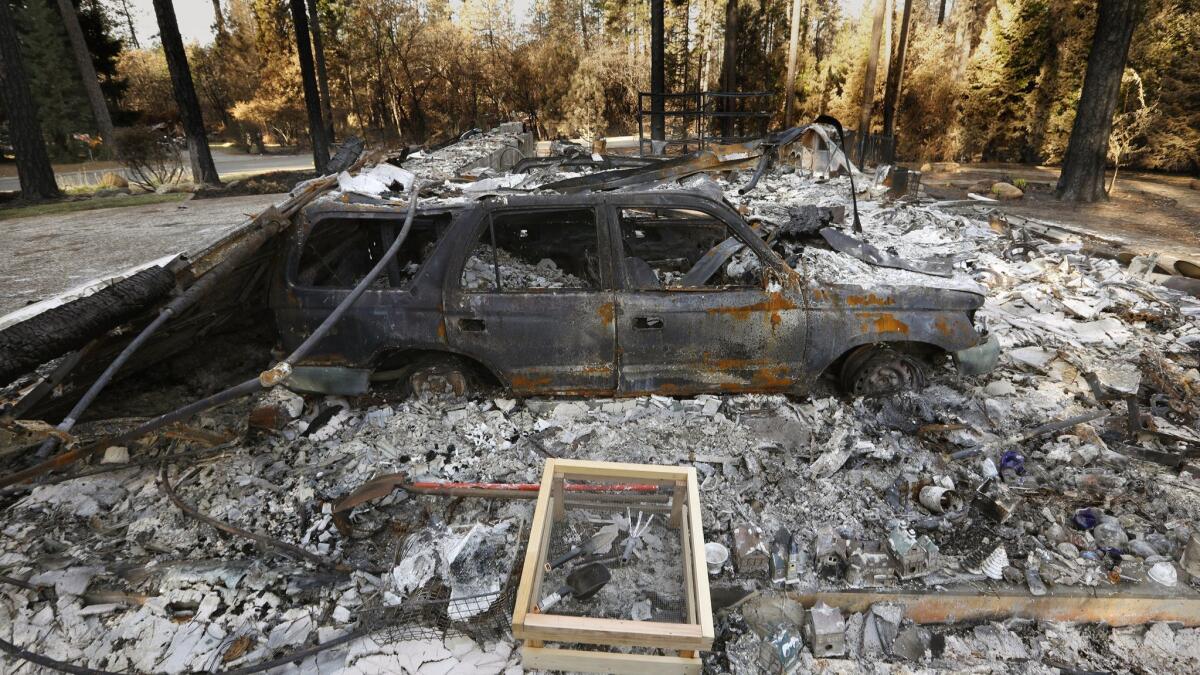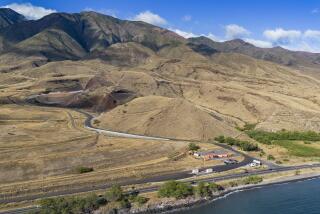Millions of tons of Camp fire debris needs to go somewhere — but no one wants it

The long road to recovery in the town of Paradise starts with removing millions of tons of charred rubble left in the Camp fire’s wake.
But the question remains: Where will it all go?
Disaster officials are scrambling to secure a place to sort and process the remnants of nearly 19,000 structures destroyed in the wildfire that began on Nov. 8 and killed 86 people. The mammoth undertaking has been slowed by staunch opposition in nearby communities eyed as potential sites for a temporary scrapyard, which would receive 250 to 400 truckloads of concrete and metal each day.
First it was Chico, where in late December residents persuaded the Federal Emergency Management Agency and the California Office of Emergency Services — the agencies responsible for the cleanup — to look elsewhere.
Inundated with Camp fire survivors, Chico is a ‘city within a city’ »
Now officials are considering Oroville, where they’ve proposed opening a scrapyard at a Superfund site near Highway 70 that served as the Koppers wood treatment plant for decades. Federal officials argue that, after years of soil and groundwater cleanup, the land is safe enough for industrial use. The site would be open for at least a year.
But some residents do not trust that the land is as clean as the U.S. Environmental Protection Agency says it is and worry that such intense operations could kick up toxic dust and damage local roadways.
“We’ve been through enough already,” Oroville Councilwoman Linda Draper said. “We’re hoping that they will listen to our concerns and think about putting it elsewhere.”
The proposal to open a scrapyard at this particular site has struck a nerve. At a town hall meeting in December, residents spoke of losing family members who worked at the Koppers site to cancer. (State health officials tried to determine a decade ago why the number of pancreatic cancer cases in Oroville unexpectedly doubled in 2004 and 2005, but results were inconclusive.)
And residents are still reeling from the Oroville Dam’s spillway collapse in February 2017, which turned the small city into a bustling construction zone, deteriorating roadways and intensifying traffic. Butte County filed a lawsuit against the state Department of Water Resources in August, seeking compensation for its damaged streets.
Officials have investigated more than 50 sites in a 30-mile radius of Paradise, including quarries and concrete recycling facilities, as potential depositories for the fire debris.
The 200-acre Koppers site was identified as an ideal location based on a few factors, according to Mike Petersen, spokesman for the U.S. Army Corps of Engineers, which is tasked with developing the debris removal plan. The Superfund site is close to Paradise and a rail spur, he said, and the area already is zoned for industrial use. It’s also half a mile away from the closest home.
Officials collected public comments through Thursday and hope to make a decision about the site within the next week, Petersen said.
It was during the public feedback period in December that Chico residents made a case for why the fire rubble should not be processed next to the Barber Yard neighborhood on the south side of town. Officials ultimately abandoned the proposal after determining that roads in the residential area were not built to withstand the weight of industrial trucks and equipment and that the activity could affect traffic to nearby businesses.
In both Chico and Oroville, environmental concerns have trumped all others, including noise and traffic. Though only non-toxic concrete and metal would be processed at the site — hazardous waste such as car batteries, electronics and asbestos will be sent to designated landfills in California and Nevada — residents worry that toxic dust could blow off the debris and compromise air quality.
At the Koppers site, protective geotextile fabric would be placed on top of the existing soil to prevent any contaminated ground from being disturbed, according to an environmental assessment prepared by the Army Corps of Engineers. Contractors would be unable to draw water or dig at the site, and materials would be rinsed of ash and oils before arriving in Oroville.
But such assurances are not enough for Oroville resident and local environmental activist Bill Bynum. Through his work with the Butte Environmental Council, he’s raised concerns about the possible health effects of two large fires at the Koppers site, one in 1963 and another in 1987. According to the county, the fires may have caused an airborne release of dioxins. Those chemical compounds are known to cause cancer as well as reproductive and developmental problems.
Bynum said the Koppers site should not be reopened for industrial use until the potential hazards are fully understood over time.
“We don’t see this as an emergency,” said Bynum, 72. “We’re wondering, why the rush? Why aren’t they doing the sorting in Paradise?”
The debris can’t be processed in Paradise itself, officials say, because such a large operation could impede swift reconstruction efforts there. And time is of the essence: The sooner the rubble is removed, the sooner residents can begin to rebuild or, at the very least, move trailers onto their properties.
Most of the non-hazardous concrete and metals recovered from the massive wildfire will be recycled and used in reconstruction efforts, Petersen said.
For all the opposition it faces, the Oroville proposal has also seen some support. Oroville Mayor Chuck Reynolds said he understood the concerns; his uncle, who worked at the Koppers plant, also died of cancer. But Reynolds said he trusted federal officials when they said the land was safe for industrial use, and Oroville — which has a median household income of around $35,000, according to the U.S. census — could use the contracting jobs tied to such a large project.
“We can’t just leave it vacant forever,” Reynolds said of the Koppers site. “At some point, we have to move on.”
laura.newberry@latimes.com | Twitter: @LauraMNewberry
More to Read
Sign up for Essential California
The most important California stories and recommendations in your inbox every morning.
You may occasionally receive promotional content from the Los Angeles Times.










